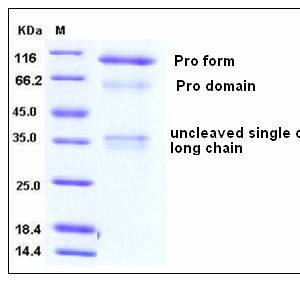Human HGFA Protein (His Tag)
HGFA,MGC138395,MGC138397,RP11-529E10.2
- 100ug (NPP3919) Please inquiry
| Catalog Number | P10329-H08H |
|---|---|
| Organism Species | Human |
| Host | Human Cells |
| Synonyms | HGFA,MGC138395,MGC138397,RP11-529E10.2 |
| Molecular Weight | The recombinant human HGF activator consists of 631 amino acids and has a predicted molecular mass of 68.2 kDa. As a result of proteolysis or autocatalysis and glycosylation, it migrates as four bands (34, 37, 65, 105 kDa) in SDS-PAGE under reducing conditions, corresponding to the active long chain, uncleaved single chain (long chain + short chain), pro doamin and the full-length pro form of HGFA respectively. |
| predicted N | Gln 36 |
| SDS-PAGE |  |
| Purity | > 95 % as determined by SDS-PAGE |
| Protein Construction | A DNA sequence encoding the human HGF activator precursor (NP_001519.1) (Met 1-Ser 655) was expressed with a fused polyhistidine-tag at the C-terminus. |
| Bio-activity | |
| Research Area | |
| Formulation | Lyophilized from sterile PBS, pH 7.4 1. Normally 5 % - 8 % trehalose, mannitol and 0.01% Tween80 are added as protectants before lyophilization. Specific concentrations are included in the hardcopy of COA. |
| Background | HGF activator (HGFA) is a serum-derived serine protease and belongs to the peptidase family S1.HGFA is responsible for the conversion of hepatocyte growth factor (HGF), from the inactive single-chain precursor to the active heterodimeric form, which is a potent mitogen, motogen, and morphogen for liver cells, epithelial cells, and endothelial cells. HGFA is synthesized and secreted by the liver and circulates in the plasma as an inactive single-chain zymogen in normal states. The zymogen is cleaved by thrombin or thermolysin through the endoproteolytic process and forms an active heterodimer linked by a disulfide bond. In turn, the active protease can be inhibited by HGFA inhibitors (HAIs) including HAI-1 and HAI-2. In addition, the HGFA zymogen acquires a strong affinity upon activation and thus may ensure the local action in tissue regeneration in liver, kidney and skin. It has been reported that activation of HGF is a critical limiting step in the HGF/SF-induced signaling pathway mediated by Met, and accordingly, aberrant expression of HGFA is implicated in tumorigenesis and progression. |
| Reference | 1. Shimomura, T. et al., 1993, J. Biol. Chem. 268: 22927-22932. 2. Miyazawa, K. et al., 1996, J. Biol. Chem. 271 : 3615-3618. 3. Shia, S. et al., 2005, J. Mol. Biol. 346: 1335-1349. 4. Kataoka, H. et al., 2000, J. Biol. Chem. 275: 40453-40462. 5. Tjin, E.P. et al., 2006, Blood. 107: 760-768. 6. Kitajima, Y. et al., 2000, Cancer. Res. 60: 6148-6159. |
